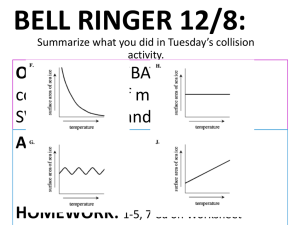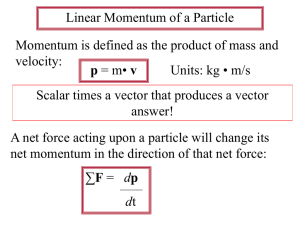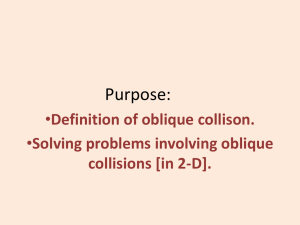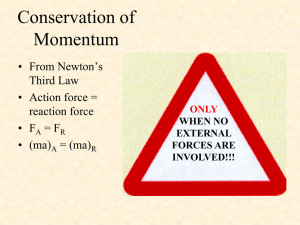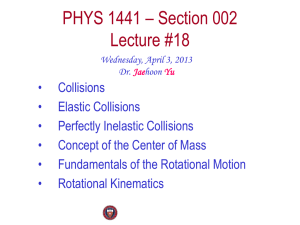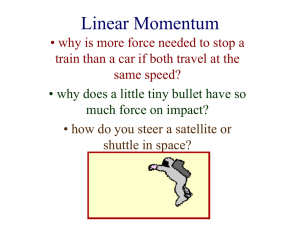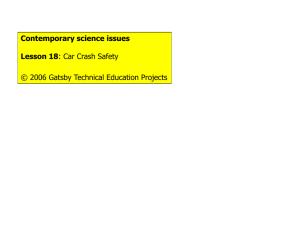Collision: Elastic & Inelastic Conservation of Momentum
advertisement
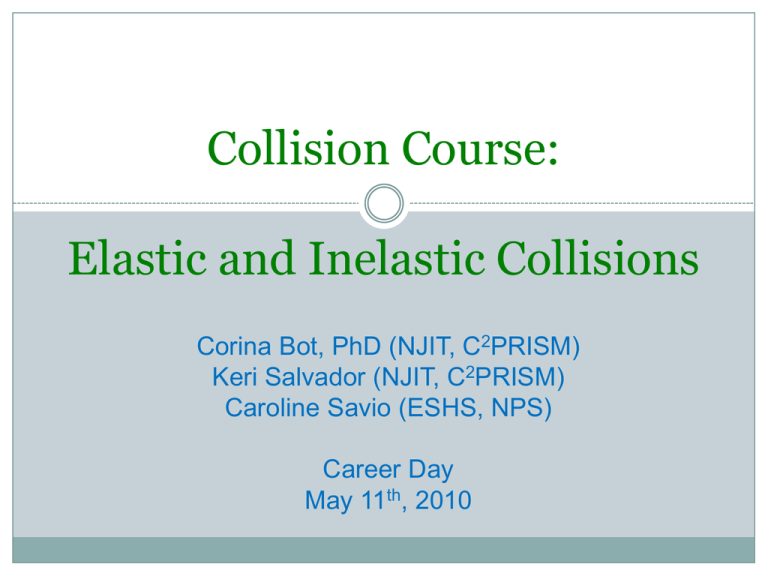
Collision Course: Elastic and Inelastic Collisions Corina Bot, PhD (NJIT, C2PRISM) Keri Salvador (NJIT, C2PRISM) Caroline Savio (ESHS, NPS) Career Day May 11th, 2010 Outline of Presentation About Collision Course Applet Lesson Plan in Conjunction with Applet Conclusion and Questions Concepts Behind Collision Course Applet Used to distinguish elastic and inelastic collisions Conservation of momentum Elastic collision Conservation of momentum m 1 v1 i m 2 v 2 i m 1 v1 f m 2 v 2 f v1 i v 2 i v1 f v 2 f momentum before collision = momentum after collision results before = results after Inelastic collision Conservation of momentum m 1v1i m 2 v 2 i m 1 m 2 v f momentum before collision = momentum after collision results before = results after Introduction to Collision Course Applet Designed by C2PRISM Fellow Corina Bot, PhD. Dr. Bot interviewed six Advanced Placement Physics students at once via focus-group . Students really liked the idea of acquiring a physics concept shaped as a game. Features of Collision Course Applet Multiple choice question game Takes place in neutral setting Player chooses which car to drive Contains sound effects Visible damage in the cars after collisions Cartoon policeman assigns ticket at collision scene Player must distinguish whether collision was elastic or inelastic A correct answer -> policeman gives you points and your ticket is void An incorrect answer -> policeman gives you a ticket and you lose points Specifics on Applet Creation Java applet developed by software engineer students at NJIT Flash software/plug-in required PC and Mac OS Compatible Outline of Presentation Lesson Plan in Conjunction with Applet Lesson Plan in Conjunction with Applet Engagement and Assessment Ideally, students work independently on applet using computers in lab classroom. If there are not enough computers in classroom, work in pairs. Or perform applet in computer lab instead of physics lab. Formative Check The applet consists of multiple choice questions that evaluate the student’s understanding of types of collisions. Lesson Plan in Conjunction with Applet Some practice problems Mario and Luigi on Bumper Cars The physics classroom http://www.physicsclassroom.com/Class/momentum/u4l2d.c fm Elastic collision Input: m1 = 300 kg m2 = 400 kg v1i = 20 km/h v2i = 0 km/h Calculate: v1f =? v2f = ? Momentum is conserved! Solution m 1 v1 i m 2 v 2 i m 1 v1 f m 2 v 2 v1 i v 2 i v1 f v 2 f Inputs: m1 = 300 kg m2 = 400 kg v1i = 20 km/h v2i = 0 km/h (1) f (2) Substitute values given in problem into equation (1): km 300 kg 20 0 300 kg v1 f 400 kg v 2 h 6000 kg km 300 kg v1 f 400 kg v 2 h f Calculate: v1f=? v2f = ? f (3) Substitute values given in problem into equation (2): km 20 h v2 f 0 v1 f v 2 km v1 f 20 f (4) h Substitute equation (4) in equation (3): 6000 kg km 300 kg v1 f 400 kg v1 f 20 h km h 6000 kg km 300 kg v1 f 400 kg v1 f 8000 kg h 2000 kg km h v1 f v2 f 700 kg v1 f 2000 km 700 h v1 f 20 km h 2 . 85 km h 2 . 85 km h 20 km h 17 . 14 km h km h Inelastic collision Input: m1 = 300 kg m2 = 400 kg v1i = 20 km/h v2i = 0 km/h Calculate: vf = ? Calculate: momentum before & after collision Momentum is conserved! Solution Inputs: m1 = 300 kg m2 = 400 kg v1i = 20 km/h v2i = 0 km/h m 1 v1 i m 2 v 2 i m 1 m 2 v f 300 kg 20 km h 6000 kg km 6000 km 700 Calculate: vf=? 700 kg v f h vf 0 300 kg 400 kg v f 8 . 57 h km h momentum before collision = momentum after collision m 1 v1 i m 2 v 2 i m 1 m 2 v f 300 kg 20 km h 6000 kg km h 0 300 kg 400 kg 8 . 57 5999 kg km h km h Conclusions Many senses engaged in learning process Group discussion with class Group instruction with visual demonstration Independent work on applet and on practice problems Paired work (optional) Students will qualitatively and quantitatively distinguish elastic from inelastic collisions. Questions? Thank You!

